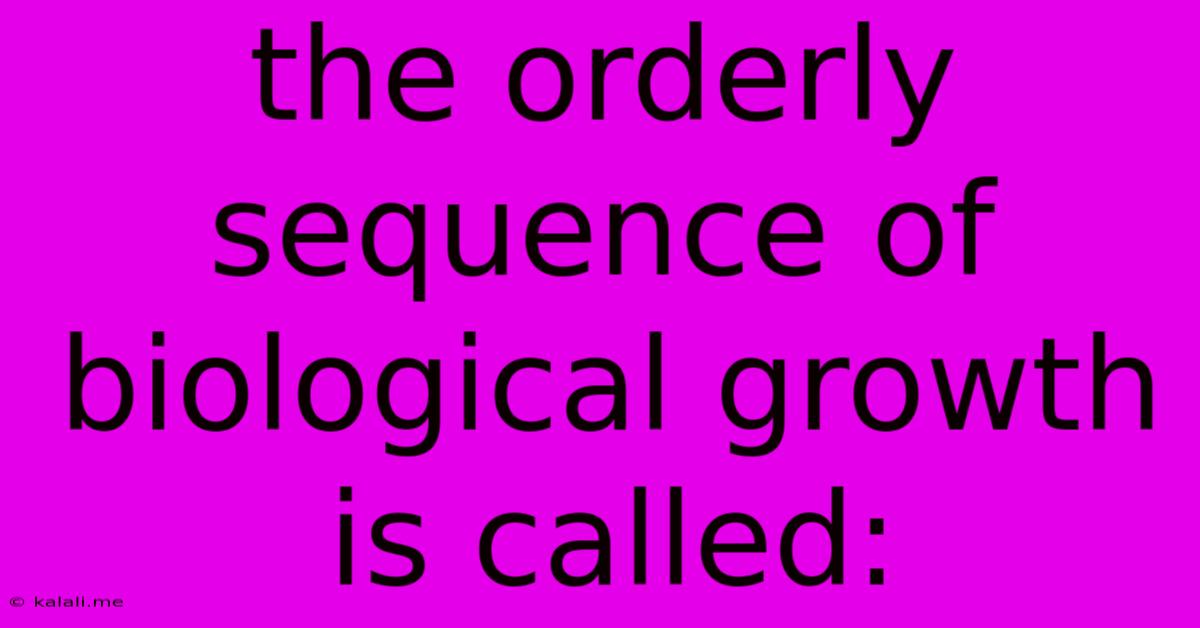The Orderly Sequence Of Biological Growth Is Called:
Kalali
Jun 12, 2025 · 3 min read

Table of Contents
The Orderly Sequence of Biological Growth is Called: Development
The orderly sequence of biological growth is called development. This encompasses the complex series of changes that occur throughout an organism's lifespan, from the single-celled zygote to a fully mature adult, and even includes senescence and death. Understanding biological development is crucial to grasping the intricacies of life, from the molecular mechanisms driving cellular differentiation to the ecological pressures shaping evolutionary adaptations. This article will delve into the key aspects of biological development, exploring its stages, influencing factors, and its significance in the broader context of biology.
Stages of Biological Development
Development is not a linear process; rather, it's a dynamic interplay of various stages, each characterized by specific events and milestones. These stages can be broadly classified as follows:
- Gametogenesis: The formation of gametes (sperm and egg cells) through meiosis, a specialized type of cell division that halves the chromosome number. This is a crucial initial step, setting the stage for the next phase.
- Fertilization: The fusion of male and female gametes, resulting in the formation of a zygote, a single cell containing the complete genetic blueprint of the new organism. This marks the beginning of the embryonic stage.
- Embryogenesis: The period of rapid cell division and differentiation, leading to the formation of the basic body plan of the organism. This involves gastrulation, neurulation, and organogenesis, among other crucial processes. This stage is incredibly sensitive to environmental factors and genetic mutations.
- Growth and Maturation: Post-embryonic development involves significant increases in size and complexity, including the refinement of organ systems and the attainment of sexual maturity. This phase can span many years, with substantial variation across different species.
- Senescence: The gradual decline in physiological function associated with aging. This includes changes in cellular repair mechanisms, decreased organ efficiency, and increased susceptibility to disease.
- Death: The ultimate termination of biological processes.
Factors Influencing Biological Development
Several factors intricately interact to shape the developmental trajectory of an organism. These include:
- Genetics: The organism's inherited genetic material (DNA) provides the fundamental blueprint for development, dictating cell differentiation, tissue formation, and organ development. Genetic mutations can significantly alter the developmental process, leading to abnormalities or developmental disorders.
- Epigenetics: Changes in gene expression that do not involve alterations to the underlying DNA sequence. Epigenetic modifications, such as DNA methylation and histone modification, can profoundly influence developmental processes and can even be influenced by environmental factors.
- Environmental Factors: External influences, such as temperature, nutrition, light, and exposure to toxins, can significantly impact development. These factors can interact with genetic predispositions to influence the final outcome.
- Hormones: Chemical messengers produced by endocrine glands play critical roles in regulating growth, differentiation, and maturation. Hormonal imbalances can result in developmental abnormalities.
The Significance of Biological Development
Understanding biological development is paramount for several reasons:
- Medicine: Knowledge of developmental processes is crucial for diagnosing and treating congenital disorders, birth defects, and developmental diseases.
- Agriculture: Manipulating developmental pathways can lead to improved crop yields and livestock production.
- Evolutionary Biology: Studying development helps us understand the evolutionary relationships between organisms and the mechanisms that drive evolutionary change.
- Conservation Biology: Understanding the developmental needs of endangered species is essential for their conservation and protection.
In conclusion, development is the intricate and fascinating process that orchestrates the orderly sequence of biological growth. It's a multifaceted process shaped by the interplay of genetic, epigenetic, and environmental factors, and its understanding is vital to numerous fields of scientific inquiry and practical applications. Further research into the complexities of development continues to unravel the mysteries of life itself.
Latest Posts
Latest Posts
-
California Polytechnic State University Sat Scores
Jun 13, 2025
-
How Many Lakhs Is A Million
Jun 13, 2025
-
Which Of The Following Is Correctly Matched A
Jun 13, 2025
-
Three Phase Induction Motor Circuit Diagram
Jun 13, 2025
-
How To Subtract Two Columns In Excel
Jun 13, 2025
Related Post
Thank you for visiting our website which covers about The Orderly Sequence Of Biological Growth Is Called: . We hope the information provided has been useful to you. Feel free to contact us if you have any questions or need further assistance. See you next time and don't miss to bookmark.